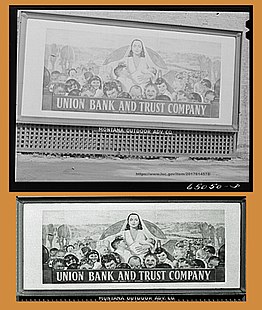Digital photograph restoration is the practice of restoring the appearance of a digital copy of a physical photograph that has been damaged by natural, man-made, or environmental causes, or affected by age or neglect.
Digital photograph restoration uses image editing techniques to remove undesired visible features, such as dirt, scratches, or signs of aging. People use raster graphics editors to repair digital images, or to add or replace torn or missing pieces of the physical photograph. Unwanted color casts are removed and the image's contrast or sharpening may be altered to restore the contrast range or detail believed to have been in the original physical image. Digital image processing techniques included in image enhancement and image restoration software are also applied to digital photograph restoration.
Background
[edit]Agents of deterioration
[edit]Photographic material is susceptible to physical, chemical and biological damage caused by physical forces, thieves and vandals, fire, water, pests, pollutants, light, incorrect temperature, incorrect relative humidity, and dissociation (custodial neglect).[citation needed] Traditionally, preservation efforts focused on physical photographs, but preservation of a photograph's digital surrogates has become of equal importance.[1][unreliable source?]
Handling practices
[edit]Fragile or valuable originals are protected when digital surrogates replace them, and severely damaged photographs that cannot be repaired physically are revitalized when a digital copy is made.[2] Creation of digital surrogates allows originals to be preserved.[3] However, the digitization process itself contributes to the object's wear and tear.[4] It is considered important to ensure the original photograph is minimally damaged by environmental changes or careless handling.[5]
Permissible uses
[edit]Digitally scanned or captured images, both unaltered and restored image files are protected under copyright law.[citation needed] Courts agree that by its basic nature digitization involves reproduction—an act exclusively reserved for copyright owners.[6] The ownership of an artwork does not inherently carry with it the rights of reproduction.[citation needed]
Images that are digitally reproduced and restored often reflect the intentions of the photographer of the original photograph.[citation needed] It is not recommended[according to whom?] that conservators change or add additional information based on personal or institutional bias or opinion.[citation needed] Even without copyright permission, museums can digitally copy and restore images for conservation or informational purposes.[citation needed]
Gallery
[edit]


See also
[edit]References
[edit]- ^ "Great Library Expectations". Great Library Expectations. Retrieved 2021-02-25.
- ^ "6.6 Preservation and Selection for Digitization". Northeast Document Conservation Center. Retrieved 2021-02-25.
- ^ "Principles of Archiving Photos and Documents". archivehistory.jeksite.org. Retrieved 2021-02-25.
- ^ bradyh (2017-04-28). "Digitizing Collections". Smithsonian Institution Archives. Retrieved 2021-02-25.
- ^ "Preservation of photographic material" (PDF). www.bl.uk. Archived (PDF) from the original on 2019-08-12.
- ^ Malaro, Marie; DeAngelis, Ildiko Pogany (2012). A legal Primer on Managing Museum Collections (3 ed.). Washington, D.C.: Smithsonian Books. p. 191.
External links
[edit] Media related to Restoration of photographs at Wikimedia Commons
Media related to Restoration of photographs at Wikimedia Commons
















